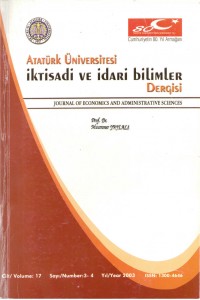Öz
Özet : Bu makalede Gramşi'nin en tartışmalı kavramlarından biri olan
sivil toplum kavramı irdeleniyor. Gramşi'de sivil toplumun altyapıya mı yoksa
üstyapıya mı ait olduğu açıklığa kavuşturulup, sivil toplum üstyapıya
yerleştirildikten sonra, bu durumun Gramşi gibi Marxist bir filozof için ne
anlam ifade ettiği tartışılıyor. Sivil toplum, politik toplum ve ekonomik alan
ayrımının Gramşi'nin çalışmalarında, organik değil, metodolojik bir ayrım
olduğu vurgulanarak, Gramşi'nin bu metodolojik ayrımı somut organik
gerçekliği, yani integral devleti, analiz etmek için nasıl kullandığı gösteriliyor.
Politik toplumla sivil toplumun bir sentezini somutlaştıran integral devletteki
liderlik kavramı ve güç (politik toplum) ile rıza (sivil toplum) arasındaki
karşılıklı ilişki açıklığa kavuşturuluyor. Gramşi'deki farklı liderlik biçimleri
tartışılıp açıklığa kavuşturulduktan sonra, Gramşi'nin, devletin farklı tarihsel
dönemlerinde liderliğin farklı sınıflar tarafından kurulduğu ve uygulandığı
çeşitli yollan incelemck suretiyle, toplumu kapitalizmden sosyalizme
dönüştürecek yeni bir politik stratejiye ulaşmayı amaçladığı ileri sürülüyor.
Abstract: This paper discusses Gramsci's concept of civil society,
which is one of Gramsci's most disputed concepts. It identifies whether civil
society in Gramsci belongs to infrastructure or superstructure. Afler placing
civil society in superstructure, it discusses the implications of this for a Marxist
philosopher such as Gramsci. By pointing out that the distinction between civil
society, political society and economic sphere is a methodological distinction,
not an organic one, it shows how Gramsci uses this methodological distinction
to analyse the concrete organic reality, the integral state. It clarifies the concept
of hegemony and the inter-relationship between coercion (political society) and
consent (civil society) in the integral state which embodies a synthesis of
political society (coercion) and civil society (consent). It, then, discussing and
clarifying the different forms of hegemony in Gramsci, argues that Gramsci, by
investigating the variety of ways in which hegemony is established and
exercised by different classes in different historical periods of the state, aims to
achieve a new political strategy that will transform the society from capitalism
to socialism.
Anahtar Kelimeler
Ayrıntılar
| Birincil Dil | tr;en |
|---|---|
| Bölüm | Makaleler |
| Yazarlar | |
| Yayımlanma Tarihi | 27 Kasım 2010 |
| Yayımlandığı Sayı | Yıl 2003 Cilt: 17 Sayı: 3-4 |





